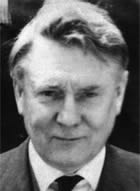|
History - People - Harry G Poole
Harry Poole, not to be confused with the football or the rugby player, was a semi-legendary figure here at UCL. Poole was one of the several Australians who came over to work at "UC". He came from Melbourne and travelled by working his passage as an able-bodied seaman. A physical chemist, Poole worked on spectroscopic problems and his thesis, which lists no supervisor was on "The dissociation of hydrogen in the glow discharge" and was presented in 1936. He joined staff of the Department in 1938 and co-authored a series of papers on the electronic and vibrational properties of one of Ingold's obsessions - benzene. He was an early pioneer of Raman spectroscopy, long before the laser made such experiments routine. For the work on benzene, which involved minuscule amounts of isotopically labelled material, he developed a micro-Raman cell. Later he was involved in the spectroscopy identification of the nitronium ion, NO2+, the key intermediate in electrophilic aromatic substitution. This led to his only Nature publication. He would later work on nitric acid and formaldehyde. In those early days, doing Raman spectroscopy was a tough business. Alwyn Davies remembers that his postgraduate students were always rather frustrated by the fact that Poole was not too keen on ordering the photographic plates they needed to record spectra. During the Second World War, the Department moved to the relative safety Aberystwyth. Poole set up the Physical Chemistry Lab there, but could sometimes be seen selling the Daily Worker on Aberystwyth street corners with Lady Ingold. Poole taught thermodynamics, kinetics and atomic theory. Like many who spend too much time thinking about thermodynamics, he was a great stickler for terminology. Alwyn Davies recalls that after the return to London in 1944 he taught quantum mechanics. Poole acquired a job lot of white coconut balls which he painted red and blue to represent atomic orbitals and would mounted a line of these on the lecture bench.. "I mentioned to Allan Maccoll how much I appreciated it as an undergraduate. "Lot of balls" was the comment." On his retirement Poole offered his models to the theoretician David Craig, who declined the offer. Jeremy Weston wrote in to tell us that "as an undergraduate in the early 1950s, I remember that Dr Poole was often late for his lectures. During a course of lectures on thermodynamics he arrived some 10 minutes late one morning, to discovered on the lecture-room blackboard one of his favourite comments "thermodynamics takes no account of the time". Around this time he was involved in the development of a high resolution spectrometer using a Lummer-Gehrke interferometer. He was also one of the earliest chemists in the department (outside of the crystallographers) to start to use electronic computers. Recalling his time in Harry's lab, Jim Parkin wrote: "Harry was extremely meticulous and enjoyed working out the details of the mathematical background to the work that we were doing. He decided that any variation in the refractive index of the air in the laboratory in D20 would significantly affect the calibration of the equipment that we used to measure the spectra. Unfortunately we were forced to share D20 with David Craig's student, Tom Claxton, who was measuring crystal spectra at liquid helium temperatures. Although Tom was very careful, Harry felt that helium was bound to leak into the atmosphere and so we had arguments which must have gone on at a higher level. We also had to be careful about temperature variations during an exposure so I had to insulate the equipment. I built a Dexion cage round it all (my experience with Meccano becoming invaluable) and filled in with polystyrene sheet. We then found that the sheet provided dust so I had the idea of wallpapering the sheets with (as I remember it) a flowery wallpaper. Harry did see the joke and he used to show visitors the transformation." We have one artefact of his - a copper punch ladle with a beautifully twisted handle. Poole himself claimed that it had belonged to William Ramsay. Len Dissado remembers that "Harry Poole's punch at Chemistry Department staff-student parties was legendary, being made with neat Ethanol and fruit using department glassware for an afternoon". But Stuart Walmsley adds that Poole always used to boil his famous punch mixture for a whole afternoon, and assumed that much of the alcohol boiled away. Unbeknownst to him, members of the Technical Staff would nip by periodically and top up the mixture with some absolute alcohol resulting in a lethal brew. Prof Barbara Banks, who knew Poole well provided us with this recipe adding "This is exactly as dictated to me by Harry in about 1962. Not exactly a precise recipe but he was, after all, only a physical chemist." Harry's Punch
Chop peeled fruit. Add rum to fruit plus half the peel and leave for 24 hours. Poole did not get on with Ron Nyholm and in last few years in the Department were probably not the happiest. He retired in 1970 having been on the staff for 32 years. We are grateful to Alwyn Davies, Barbar Banks, Jim Parkin, Len Dissado and Jeremy Weston for their contributions to this page.
This page last modified 20 September, 2010 |

